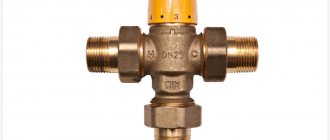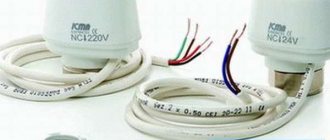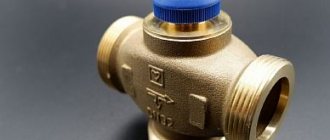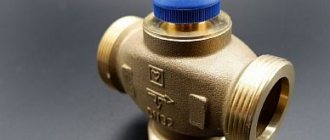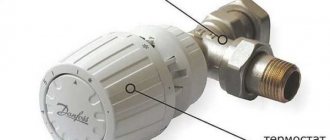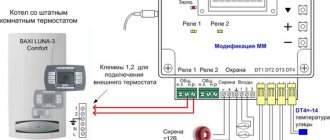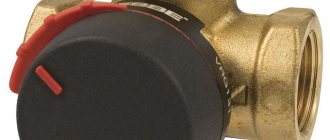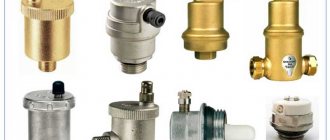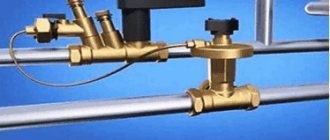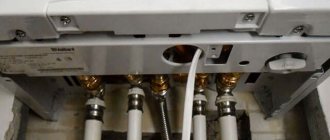A three-way valve with a thermostat for heating is an important part of the room heating control system. The function of the valve is to maintain a comfortable thermal balance throughout the entire room by adjusting the temperature of the coolant in the heating circuit. The three-way valve does not reduce the flow of the working medium, but mixes several flows into one, thereby giving it the set temperature. Another purpose of a three-way valve is to distribute coolant across different circuits. So, heating radiators should receive water of one temperature, and the temperature of the coolant in the “warm floor” system should be different.
Varieties and purpose of each type
Three-way valves are mainly divided according to their operating principle. There are three positions here:
- mixing,
- dividing,
- switchable.
The designations on the body show what type of devices they belong to.
The former mix two coolant flows with different temperatures into one, while the latter, on the contrary, divide one flow into two. And still others simply switch the movement of water from one direction (circuit) to another. The first two varieties are similar in appearance to each other, so a diagram is applied to their body, which shows for what purpose the device should be used.
As for the third position, it is easy to distinguish it from the rest. It additionally has a block with the help of which switching occurs. A valve of this type is usually installed in a dual-circuit heating system when it is necessary to redirect the coolant flow from the heating system to the boiler and vice versa.
Switching type valve
Related article:
Thermostats with air temperature sensor. A separate material provides practical guidance on the selection and installation of thermostats.
Types of thermostats for radiators
Related article:
A thermostat for a heating radiator will help maintain a comfortable microclimate in each room. This article describes the design options for these devices, methods of their installation, as well as several popular models of thermostats with prices and characteristics to make your choice easier.
Installation of thermostats is possible on battery passage plugs. With their help, the liquid supply to the product is partially or completely blocked. A faucet equipped with a thermostat works on the same principle. It is enough to set the parameters once, and the entire system will subsequently function in the specified mode. Electronic components have particular accuracy and functionality.
You should know this! The thermostat cannot change the original power data of the equipment. However, with its help you can create an optimal temperature balance and a comfortable indoor microclimate.
Thermostat installed on the radiator
The design and principle of operation of a three-way valve in a heating system
So, first of all, let's look at the device. To make it easier to understand what’s inside the valve, you need to look at the photo below, which shows the device in cross-section. It consists of three pipes (two side, one bottom), between which the mixing chamber is located. On the fourth side (top) there is a thermal head responsible for controlling the temperature of the coolant.
Sectional view of a three-way valve
Inside the device, from the thermostat there is a spring-loaded rod with two flat round valves. Their diameter corresponds to the diameter of the nozzle seats. Instead, one ball valve can be installed, located inside the mixing chamber between two seats. When there is pressure on the rod, the valves partially block the flow from the lower pipe and open the upper one. The same thing only happens the other way around if the rod rises up.
But here you need to figure out what laws the rod works by, under what force it lowers or rises. It's all about the thermal head itself. Inside it is a temperature sensor filled with a special liquid. She is heat sensitive. As soon as the temperature of the coolant begins to rise, the liquid expands and rises through the capillary tube into a special bellows (container), which is located in the thermal head. The reservoir itself begins to expand, which puts pressure on the rod. The latter lowers and opens the lower pipe, from where cold water flows into the three-way valve. Hot water comes from the left pipe (see photo).
Separating and mixing valves
Of course, pressure simply cannot happen with any increase in water temperature. To do this, a temperature gradation is installed on the thermal head, which is adjusted manually. It is the set parameter that is the moment of pressing the rod.
So, the rod reacted to the change in the temperature of the coolant in the supply pipe, opened the lower one for cold water, and inside the valve the hot and cold media were mixed to the required temperature. That is, it turns out that the temperature of the coolant at the inlet has not changed, but at the outlet it has become lower.
If the coolant continues to heat up, the rod can drop to the lowest possible position. That is, it will completely close the hot water supply and completely open the cold water supply. And this will continue until the coolant inside the heating system drops to the required temperature. After which the top valve will open, it will release hot water.
Scheme of mixing coolant with return
This is how a three-way mixing control valve works. As for the separation model, its operating principle is almost the same, only in reverse. The coolant enters one pipe; inside the device body it is divided into two streams and exits through two adjacent pipes.
This type of shut-off valve is installed in those areas where the coolant flow needs to be divided into two circuits. One of them will have a constant thermal regime, the other will have a variable one. The first is the fluid flow, which has quality requirements. The second with quantity requirements. In this case, purely structurally, the flow with a constant hydraulic regime is never blocked, because in the design of the device, the length of the rod is made in such a way that the valve does not close the constant circuit.
But it is necessary to indicate that the length of the rod can be adjusted. This makes it possible to adjust the required volume of coolant on a constant circuit. As for the variable, it can completely overlap. This is how the flow and pressure of the coolant in the heating system is regulated. As you can see, the operating principle of a three-way valve is quite simple. The main thing is to accurately select the type of device and install it in the required location in the circuit.
How does a three-way thermostatic valve work in a heated floor system?
To make it clear how the circuit with the valve works, we can give an example of coolant circulation in a heated floor system. The three-way valve for underfloor heating is a mixing valve. The circulation scheme here is as follows:
- hot water enters the underfloor heating system through the collector;
- it must have a certain temperature, which is monitored precisely as it passes through the three-way valve;
- as soon as its value exceeds the permissible value, the valve opens one of the circuits, which is connected to the heating return;
- cooled coolant enters inside, lowering the temperature,
- after which the mixed water enters the heating circuit of the heated floor;
- as soon as the temperature drops to the required value, the return circuit inside the valve is closed with a rod.
Piping for underfloor heating with a three-way valve
Design and working principle of three-way valve
Very often the product looks like a simple tee made of brass or bronze, with an adjusting washer placed on top. Below it is a heat-sensitive component that presses on the operating rod extending from the housing. From the inside, a cone is attached to the rod, which fits tightly into the saddle. To understand how a three-way valve does not stop working, you need to learn its cross-sectional structure:
Three Way Thermostatic Mixing Valve
Water moves through the front and right sections of the pipe until its temperature rises or falls to a given value. The task and working principle of a three-way valve is to maintain the temperature of the coolant at the outlet within specified limits by mixing cold or hot water (depending on the circuit) from the left section of the pipe. When the parameters of the coolant go beyond the specified limits, the external drive presses on the rod. When it moves, the cone comes out of the seat and opens communication between all three channels. The process lasts until the front inlet section of the pipe is completely blocked, if the temperature parameters of the water do not stop changing.
Three way valve with thermal head
There is an internal valve mechanism of a different type; its design is similar to a ball valve. Such a three-way switching valve, instead of a seat with a cone, has a ball on the inside with a recess of a specialized shape. To redistribute the flow of heat carrier in such products, the drive must not press, but rotate the rod on which the ball is attached. Ball valves are not manufactured with high flow capacity and are mainly used in domestic heating systems. Another type of mechanism is that there is not a ball on the rod, but a section whose working part completely or partially closes one or two flows based on this.
Three way valve operation
Three-way valves with actuators
Experts say that adjusting a three-way valve using a thermal head and sensor is the simplest and most accurate. In addition, there is no energy consumption. This is why this type of three-way valve is popular today. But you can control the process in other ways. The simplest one is manual. Let's face it, it's not the most accurate option, because the range of the rod's immersion depth is set by a handle located outside the valve body.
Attention! A valve with such an adjustment is recommended to be used only in those heating systems where the temperature differences of the coolant are insignificant.
The second option is temperature control using electric drives. They receive commands from the controller.
Three-way valve with drive
Motorized 3-way valve
Motors mounted on valves are often called servos. In fact, these are ordinary electric motors in which the shaft does not rotate, but rotates by a certain degree. It should be noted that this category includes any types of engines, for example, thermal ones. The main thing is to fulfill the condition of rotation, not rotation.
Manufacturers today offer two items regarding configuration. The first is a complete package that includes a controller and temperature sensor. It is possible to immediately adjust the device to the required temperature, as well as to the rotation angle, for example, from 0 to 180°. In this case, any intermediate values are possible. The second is a separate drive with a sensor inside, to which you need to add a controller as a separate element.
Cast iron fittings with servo drive for large heating networks
As for the controller, it is a device that solves problems of signal management. In the case of heating, it reacts to temperature changes that are signaled to it by a temperature sensor. It processes the signals and decides what to do - open the valve or close it, or rather, turn it clockwise or counterclockwise. Today, manufacturers offer a huge model line of three-way valves with electric drives. One of the most popular brands is “ESBE” (Sweden).
Electrically actuated 3-way valve ESBE
First of all, it should be noted that this brand of valve has a ball inside with through slots. The latter open or close two channels, the third always remains open. Through it, coolant enters the heating system. Rotation degree – 90÷180°.
ESBE from a Swedish manufacturer
In stores, the valve of this model is sold separately from the servo drive, so before installation they are connected to each other by inserting the actuator axis (shaft) into the upper part of the rod. There is a hole in it for the axle. After that, you need to carry out adjustments in terms of temperature conditions exactly according to the instructions included with the device.
Today, the manufacturer offers a fairly wide range of ESBE three-way valves with and without a drive:
| Photo | Model | Purpose |
| VTA 200 | Designed for systems where there is no water recirculation. | |
| VTA 270 | This is a thermo-mixing valve for underfloor heating. It is installed if heating is organized in a room with an area of at least 100 m² | |
| VTA 310 | Valve for general use in any heating systems where the coolant temperature does not exceed +95°C and the pressure is 0.3 atm. | |
| VTA 300/ VTA 360 | The two models differ from each other only in the direction of movement of water in the heating system. The temperature is well controlled even during pressure surges within the network. | |
| VTC300 | This is a three-way valve without servomotor. It can be installed in systems that use low-power boilers - up to 30 kW. | |
| DN25 | This is a three-way valve for solid fuel boilers. That is, it can withstand coolant temperatures up to +110°C. In this case, the boiler power should not be less than 150 kW. This is one of the most unpretentious devices on the market. It can work under any conditions in any heating networks without changing quality. | |
| VRG131 | This is the most popular and in demand device, which is used in apartments and private houses. |
Other models of three-way valves
Another well-known brand is the Navien three-way valve from a South Korean company. It should be noted that this device is an integral part of the double-circuit boiler of this manufacturer. And it is installed inside the heating equipment. Its main purpose is to separate the coolant into the heating network and the hot water supply.
Attention! Navien valves cannot be repaired. The main cause of failure is the gear transmission from the motor to the rod. Spare parts are not sold anywhere. If the device fails, it must be replaced with a new one.
Three way valve Navien
The Danish company Danfoss is a well-known manufacturer of three-way valves. It offers four models that are designed for different systems:
| Photo | Model | Purpose |
| VF3 | Used in air conditioning and heating systems. Manufacturing material – cast iron. With flange connection. | |
| VMV | For use in heating systems only. Material of manufacture: bronze or stainless steel. | |
| VRB3 | This is a mixer that is used in both heating systems and refrigeration systems. Material – stainless steel. | |
| VRG3 | Installed in heating networks or when transporting refrigerant. The material is either stainless steel or cast iron. |
Usage and connection diagrams
In order to prevent cold coolant from entering the jacket of a solid fuel boiler when it is heated, a connection diagram for a three-way valve with a primary circulation circuit is used:
Three way valve connection
A three-way valve cuts off cold water from the return pipeline so that condensation does not appear on the walls inside the solid fuel boiler chamber, which can significantly reduce the service life of the unit. The coolant moves in the primary circuit until it heats up to the temperature set on the valve thermoelement, in most cases this is 40-50? C. Once this temperature is reached, the thermostatic valve acts on the stem, gradually opening the flow of cold water from the heating system. To hydraulically adjust the entire system, a balancing valve is embedded in a small circuit. For normal operation of the boiler piping circuit, the circular pump must be installed after the three-way valve, and not in front of it; this is a very common mistake.
A continuation of this scheme could be the organization of a secondary circulation circuit, which involves its own pump and three-way valve for heating. The connection is made according to the following scheme:
Three way changeover valve
In the secondary circuit, hot water from the boiler is added to the heating system if there is a need for this, and the pump ensures circulation in this circuit. The three-way valve and pump are controlled by a controller, which receives information about the parameters of the coolant from sensors. The selection of water for an electric water heater is carried out between 2 circuits, where the coolant has the highest temperature; the connection of a three-way valve to the boiler in the primary circuit is done as shown in the previous diagram.
Most manufacturers of boiler room equipment install an additional circuit in their own heating units to equip DHW consumers. In order to maintain the parameters of hot water supplied to the house, equipment for switching the key pipe coil to the DHW circuit and back is installed from inside the boiler. The working principle and design of the three-way gas water heater valve involved in this process differs little from the products described above. There is a slight difference in the design, which is a straight manifold; a component moves from inside it, covering the side sections of the pipe. The rod rotates using a servo drive upon command from the built-in control unit of the boiler.
Another area of use is the control of floor heating; to do this, in most cases a three-way valve with a thermal head and a remote thermal converter is used. The general scheme looks like this:
Three-way mixing valve with thermal head
The circuit ensures that all living spaces are supplied with a coolant at the same temperature. A three-way valve is necessary to prevent overheating, since underfloor heating systems will not require the same hot water as that coming from the boiler room. The pump circulates in all circuits, and the valve mixes hot coolant into the supply manifold if necessary. Such a mixing unit is one of the simplified connection options; the diagram becomes difficult when temperature adjustment is required in all rooms separately.
Connection diagrams for a three-way valve to a heating network
After all the analysis regarding the design of the valve and its operating principle, an understanding emerged of how it can be used in various heating systems. Most often it is used in three cases.
- In a heated floor system, the coolant temperature should be within +45°C. It is this mode that is supported by the device. This has already been discussed above, and it has been shown how it should work.
- To protect solid fuel boilers from the formation of condensation inside the firebox. This happens when relatively very cold return water enters the generator heat exchanger. This causes water droplets from condensed steam to form on the outer surfaces. This should not be allowed, because condensation shortens the life of the equipment.
- If there is a need to maintain different temperatures in different parts of the heating system.
The first option will not be considered, because it has already been described. As for the second case, we need to take the photo below as a basis for analysis.
Piping diagram for a solid fuel boiler with a three-way valve
The diagram shows a double circuit: one large one passes through the radiators, the second is a short one through the bypass (this is a vertical red line, the beginning of which is at the top to the radiators, the end rests at the bottom of the valve). Until the boiler warms up, the coolant moves along a short circuit. The temperature has risen to the required level, the valve closes the bypass and opens the return (lower blue line).
And the third position, which is based on the distribution of coolant among consumers, in them the required temperature is not always the same. For example, an indirect heating boiler requires water at a higher temperature, for radiators at a lower temperature, and for heated floors even less.
Attention! In such a scheme, there is no need to install control shut-off valves in front of the boiler.
The wiring diagram for installing a three-way valve should be approximately as shown in the photo below.
Coolant distribution among consumers
Types of valves
According to functionality, this fittings are divided into 2 types:
- Mixing valve. It has 2 inlet pipe sections and 1 outlet. Hot coolant from the boiler is supplied to one of the pipes, and the inlet of the second pipe section is combined with the “return”. Similarly, by mixing these two flows in the required proportions, the set temperature of the coolant is achieved at the outlet.
Working principle of three way mixing valve
- Dividing valve. It does the exact opposite job, zoning one flow into 2 circuits. Based on this, it only has 1 input, but 2 outputs. These taps are in demand in water heater piping systems. If you need to divide the flow of the coolant into 2 parts, then it is simply unrealistic to do without such fittings. Moreover, you can adjust the amount of liquid entering various circuits.
The design inside the two types of valves is noticeably different. A mixing-type valve has a rod with one closing element, which moves between 2 supply pipes. In the dividing valve, there are 2 similar elements on one rod. When one valve opens the first passage, the second valve automatically closes the second section of pipe.
Three-way valves for heating with a fixed coolant temperature
This is the so-called budget option. In terms of price, it is 30-35% cheaper than devices with drives. How is he different from everyone else? There are no rods, sensors, or thermal heads in its design. There is a so-called thermostatic element installed inside, which is set to a certain coolant temperature. For example, it can be either +45°C or +65°C. That is, the indicator can be anything depending on the requirements of the hot water consumer.
The element is selected at the factory and installed there, so it is necessary to indicate on the valve what the outlet temperature will be after it. For example, if you need a valve for a heated floor, then choose one with a temperature of +45°C. The positive side of these devices is their low cost. Negative – the inability to adjust the temperature of the water.
Attention! If a valve of this type is installed on the bypass of a solid fuel boiler, then it is necessary to study the passport of the generator itself before purchasing. The main indicator for the valve is the temperature of the water in the return circuit. It is for this reason that the device is selected.
Thermostatic model
The principle of operation of the thermostat
Classification according to the method of controlling the temperature of the flows
| Control type | Principle of operation | Advantages | Flaws |
| Mechanical | The basic operating principle of the thermostat is based on the physical properties of the temperature agent (gas or liquid) inside the head to expand under temperature influence. To work, just turn the knob with divisions and set it to the required temperature. | This is the simplest and most reliable device. It does not require external power to operate. | There may be an error, poor functionality |
| Electronic | Temperature control is fully automated. The data is displayed on the panel. The movement of the rod is controlled by a microprocessor. The device runs on batteries. | You can set your own comfortable temperature and set it to a time. | Large dimensions, it is necessary to monitor the battery charge and high cost |
Thermostat design
Rules for installing a three-way valve in a heating system
It is not difficult to install a three-way valve with or without a servo drive with your own hands. This is just a shut-off valve, but it should be noted that it can have different methods of fastening. There are usually two of them: threaded or flanged. In the first position, the thread can be internal or external. In any case, the connection to the pipes is made using sealing materials such as fum tape or tow. As for the flange connection, to ensure its tightness it is necessary to make a gasket from heat-resistant rubber or paranite.
Correct connection of the valve to the pipes
There are two nuances that relate to proper installation:
- The device is usually installed on the return circuit before the circulation pump, because the outlet pipe is always open.
- The valve must be installed in the pipeline system exactly in the arrow of the coolant movement. The latter is indicated on the device body.
Types of connection between valve and pipes
Prices for three-way valves
| Photo | Models | Characteristics | price, rub. |
| ESBE VRG131-25 | Connection diameter 25 mm Drive ARA661 with torque 6 Hm | 12500 | |
| ESBE VRG131-25 | |||
| ESBE VRG131-20 | Connection diameter 20 mm (threaded) Device without drive with thermal head Temperature range – 10÷110°С | 4500 | |
| ESBE VRG131-20 | |||
| Danfoss VF3-15 | Bore diameter 15 mm Temperature range 10÷130°С Flange connection Capacity 0.63 m³/h | 47000 | |
| Danfoss VF3-15 | |||
| Danfoss VRB3-32 | Bore diameter 32 mm Withstands pressure up to 16 atm. Maximum temperature +130°C Capacity 16 m³/h Material - bronze | 42000 | |
| Danfoss VRB3-32 | |||
| Navien | A universal device that is used in all types of heating boilers produced by the manufacturer. | 3000 | |
Danfoss VRB3-32
Prices for three-way valves for heating with a thermostat and actuator vary greatly. Basically, the whole point is in which heating systems they should be installed. This applies to the pressure inside the network and the temperature of the coolant. Of course, devices with a drive are more expensive.
The variety of three-way valves can sometimes make choosing them confusing. Not everyone can immediately determine which device needs to be purchased for a specific heating system. Therefore, contact us in the comments, and our specialists will answer all your questions.
